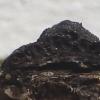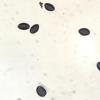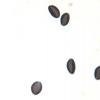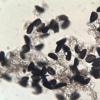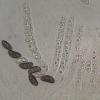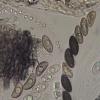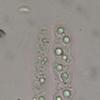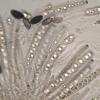
18-12-2025 17:23
 Bruno Coué
Bruno Coué
Bonjour,je serais heureux d'avoir votre avis sur c

18-12-2025 21:17
Pol DebaenstThe identification took me to Byssonectria deformi

18-12-2025 18:07
Margot en Geert VullingsThese plumes were found on rotten wood.They strong

17-12-2025 18:35
 Michel Hairaud
Michel Hairaud
Bonjour à tous/Hi to everyone I am passing along

15-12-2025 15:48
 Danny Newman
Danny Newman
Melanospora cf. lagenaria on old, rotting, fallen

15-12-2025 15:54
 Johan Boonefaes
Johan Boonefaes
Unknown anamorph found on the ground in coastal sa

15-12-2025 21:11
 Hardware Tony
Hardware Tony
Small clavate hairs, negative croziers and IKI bb

15-12-2025 07:09
 Danny Newman
Danny Newman
indet. Rutstroemiaceae sp. on unk. fallen leavesMc
Xylariaceae?
Lepista Zacarias,
18-03-2016 20:22
I was not able to see any asci, but the spores are distinctive, with the following dimensions:
(13.5) 14 - 15.3 (15.6) × (7) 7.6 - 9.7 (11) µm
Q = (1.3) 1.4 - 2 (2.1) ; N = 26
Me = 14.6 × 8.5 µm ; Qe = 1.7.
I would apppreciate some help for its classification.
Thanks,
zaca
Jacques Fournier,
18-03-2016 21:55

Re : Xylariaceae?
Hi Zaca,
the substrate looks like bark, not herbaceous and the ascospores are not intact, most of them are burst with the germ slit wide open. I agree it is xylariaceous, likely Hypoxylon fuscum.
Cheers,
Jacques
the substrate looks like bark, not herbaceous and the ascospores are not intact, most of them are burst with the germ slit wide open. I agree it is xylariaceous, likely Hypoxylon fuscum.
Cheers,
Jacques
Lepista Zacarias,
18-03-2016 22:15
Re : Xylariaceae?
Merci Jacques,
For your opinion . It has the overall appearance of Hypoxylon , but I do not know how to separate it from the other Xylareaceae . You must be right Also about the host, but the observation was made at a place with tropical vegetation (tropical garden inside the city) and I don't know how to classify the plant ; It was not a tree or shrub but it has some bulbous base where the fungus developed.
Thanks again for your help,
Grateful,
zaca
For your opinion . It has the overall appearance of Hypoxylon , but I do not know how to separate it from the other Xylareaceae . You must be right Also about the host, but the observation was made at a place with tropical vegetation (tropical garden inside the city) and I don't know how to classify the plant ; It was not a tree or shrub but it has some bulbous base where the fungus developed.
Thanks again for your help,
Grateful,
zaca
Lepista Zacarias,
20-03-2016 00:25
Jacques Fournier,
21-03-2016 09:01

Re : Xylariaceae?
Hi Zaca,
now that you have seen asci which are unitunicate, cylindrical, with an amyloid apical apparatus and brown one-celled ascospores you are indeed dealing with a Xylariaceae. The stroma surface is coloured, inside is homogeneous, a small chip of external stroma should yield pigments in a drop of 10% KOH. If the pigment is greenish yellow to dark olivaceous, depending on how big is the chip of stroma and if ascospores have a sigmoid germ slit and a perispore dehiscing in 10% KOH, you can consider H. fuscum.
The fact you found it in a tropical environment expands considerably the range of possible species, especially if there are tropical shrubs and plants imported from tropics.
Now check the pigments, the perispore and the germ slit and get back to the forum.
Cheers,
Jacques
now that you have seen asci which are unitunicate, cylindrical, with an amyloid apical apparatus and brown one-celled ascospores you are indeed dealing with a Xylariaceae. The stroma surface is coloured, inside is homogeneous, a small chip of external stroma should yield pigments in a drop of 10% KOH. If the pigment is greenish yellow to dark olivaceous, depending on how big is the chip of stroma and if ascospores have a sigmoid germ slit and a perispore dehiscing in 10% KOH, you can consider H. fuscum.
The fact you found it in a tropical environment expands considerably the range of possible species, especially if there are tropical shrubs and plants imported from tropics.
Now check the pigments, the perispore and the germ slit and get back to the forum.
Cheers,
Jacques



